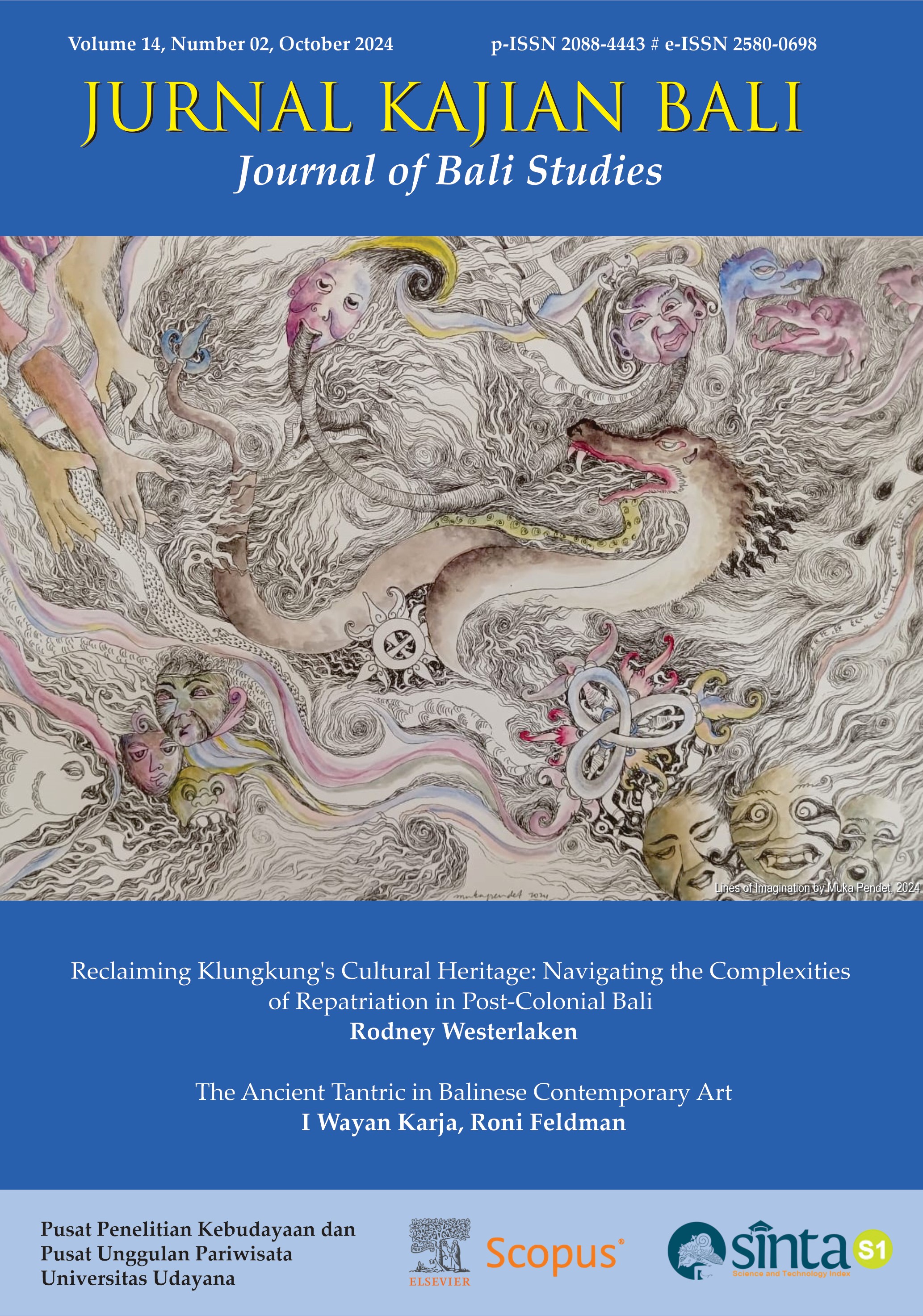Macau, Bali and the Malay World: A Gastronomic Perspective
Abstract
Macau’s location on the South China Sea suggests that any syncretic activity would have been of Sinitic-Portuguese variety. However, the situation is rather more nuanced, as the culture of the Macanese people, who consider themselves the ‘sons of the land’, reflects Portuguese colonial activity across the Indian Ocean and especially Malacca. Links between Macau and the ‘Malay World’ are deep and complex, and this paper approaches this issue through historical and political analysis, but also through the specifics of etymology and cuisine. The paper also draws comparisons with other ‘creolised’ cuisines in Southeast Asia such as Peranakan food in Malaysia and Western-Indonesian hybrids that have arisen in the tourism context of Bali. Given the importance played by women in preparing dishes for Portuguese men in Macau, parallels are drawn with the role of enslaved Hindu-Balinese women in colonial Batavia (Jakarta) who prepared pork dishes for their Dutch masters.
Downloads
References
Arvela, P. (2019). Searching for Culinary Footprints. A question of cultural identity – Kristang foodways and the Portuguese culinary legacy in Melaka in Leong-Salobir, C. (ed.) Routledge Handbook of Food in Asia. Oxford & New York: Routledge.
Baxter, A. and de Silva, P. (2004). A Dictionary of Kristang (Malacca Creole Portuguese) with an English-Kristang Finderlist. Canberra: Pacific Linguistics/Research School of Pacific and Asian Studies, Australian National University.
Bestari, N. M. P., Wiranatha, A. S., Suryawardani, I. G. A. O., & Putra, I. N. D. (2022). Rejuvenating Cultural Tourism Through Gastronomic Creative Tourism in Ubud Bali. Mudra Jurnal Seni Budaya, 37(2), 136-145.
Chaudenson, R. (2001). Creolization of Language and Culture. Translated from the French by S. Pargman, S. Mufwene, S. Billings and M. Aucoin. London: Routledge.
Clammer, J. (1980). Straits Chinese Society: Studies in the Sociology of the Baba Communities of Malaysia and Singapore. Singapore: Singapore University Press.
Clayton, C. (2009). Sovereignty at the Edge: Macau & The Question of Chineseness. Cambridge, Mass: Harvard University Press.
De Silva Jayasuriya, S. (2008). The Portuguese in the East: A cultural history of a maritime trading empire. London: I.B. Tauris.
Fernandis, G. (2003). The Portuguese Community at the Periphery: a minority report on the Portuguese quest for Bumiputera status. Kajian Malaysia XXI (1&2): 285-301.
Geertz, C. (1973). Thick Description: Toward an Interpretive Theory of Culture, The Interpretation of Cultures: Selected Essays, New York: Basic Books, pp. 3–30
Geertz, C. (2017). The Interpretation of Cultures. 3rd edn. New York: Basic Books.
Havik, P. and Newitt, M. (eds.) (2015). Creole Societies in the Portuguese Colonial Empire. Cambridge: Cambridge Scholars Publishing.
Hitchcock, M. (1996). Islam and Identity in Eastern Indonesia. Hull: Hull University Press.
Hoogervorst, T. (2018). Sailors, Tailors, Cooks, and Crooks: On Loanwords and Neglected Lives in Indian Ocean Port. Itinerario 42 (3): 516-548.
Jackson, A. (2003). Taste of Macau: Portuguese Cuisine on the China Coast. Hong Kong: Hong Kong University Press.
Jackson, A. (2020). The Making of Macau’s Fusion Cuisine: from family table to world stage. Hong Kong: Hong Kong University Press.
Jorge da Silva, A. (2016). Macaense Cuisine: Origins and Evolution. Macau: IIM.
Katayose, M. (2013). Tracing the Roots of Nanban Cuisine. Food Culture.
Lam, W.M. (2010). Promoting Hybridity: The Politics of the New Macau Identity. The China Quarterly 203: 656-674.
Lee, S.K. (2008). The Peranakan Baba Nyonya Culture: Resurgence or Disappearance? Sari 26: 161-170.
Lévi-Strauss, C. (1997). The Culinary Triangle in Counihan, C. and Van Esterik P. (eds.) Food and Culture: A Reader. Translated from the French by P. Brooks. New York: Routledge.
Lincoln, Y.S. & Guba, E. G. (1985). Naturalistic Inquiry. London: Sage.
Musa, N. (2016). Amazing Malaysia: Recipes for Vibrant Malaysian Home Cooking. London: Square Peg.
Ng, C.Y. and Karim, S.A. (2016). Historical and contemporary perspectives of the Nyonya food culture in Malaysia. Journal of Ethnic Food 3: 93-106.
Nunis, M. (2014). A Kristang Family Cookbook. Selangor Darul Ehsan: Marshall Cavendish Cuisine.
O'Neill, B.J. (2018). Culinary resistance? Trabalhos de Antropologia e Etnologia, 58.
Pratama, A.D.Y. (2023). Balinese Food Menu in Translation. Jurnal Kajian Bali (Journal of Bali Studies), 13(1), 64-83. doi:10.24843/JKB.2023.v13.i01.p04
Pitanatri, P. D. S., & Putra, I. N. D. (2016). Wisata kuliner: atribut baru destinasi Ubud. JagatPress bekerja sama dengan Program Studi Magister Kajian Pariwisata, Universitas Udayana.
Rodrigues, M. (2020). Macanese Cuisine: Fusion or Evolution? Review of Culture 62: 17-25.
Sarkissian, M. (2005). Being Portuguese in Malacca: the politics of folk culture in Malaysia. Centro em Rede de Investigação em Antropologia 9 (1): 149-170.
Smith, M.G. (1960). Social and cultural pluralism in the Caribbean. Annals of the New York Academy of Sciences, 83 (5): 763-785
Subadra, I. N. (2024). Managing Restaurant’s Food Loss and Waste at The Aburi Sushi Bali:
A Sustainable Culinary Tourism Enterprise Model in Bali. Jurnal Kajian Bali
(Journal Of Bali Studies), 14(1), 191-214. doi:10.24843/JKB.2024.v14.i01.p09
Tan, C.B. (2007). Nyonya cuisine: Chinese, non-Chinese and the making of a famous cuisine in Southeast Asia in Cheung, S. and Tan, C.B. (eds.) Food and Foodways in Asia: Resource, tradition and cooking. Oxon: Routledge.
UNESCO. (2020). https://en.unesco.org/creative-cities/macao accessed 20 July 2020.
Zhang, Y. and Hitchcock, M. (2014). The Chinese female tourist gaze: a netnography of young women’s blogs on Macao. Current Issues in Tourism DOI: 10.1080/13683500.2014.904845.
Zhang, Y. and Pang, C.L. (2012). From Home Food to Macanese Cuisine, Historical Development, Tourist Branding and Cultural Identity. Sociology Study 2 (12): 934‐940.
Zuryani, N. (2020). Sosio-Agrikultur Bali untuk Gastronomi Berkelanjutan di Indonesia. Jurnal Kajian Bali (Journal Of Bali Studies), 10(2), 627–650. doi:10.24843/JKB.2020.v10.i02.p13

This work is licensed under a Creative Commons Attribution 4.0 International License.



















